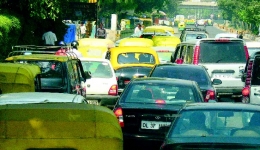It was almost 5am by the time I retrieved my bags and cleared Indian customs at the airport in New Delhi, so it was still dark when I took a taxi from the airport to my home away from home, the Hotel Empire, located in the Safdarjung Enclave not far from Jawaharlal Nehru University in south-western New Delhi. It was a conventional taxi ride in that the car not only had a taxi sign, a meter, doors and windows, but also air conditioning. I wouldn’t see another of its like until my return trip to the airport three weeks later.
That was because I soon discovered these ‘conventional’ taxis actually cost three to four times more per kilometre travelled than the ubiquitous door-less, window-less, green and yellow three-wheel ‘rickshaws’ that ply their trade throughout the city and the rest of the country. While my taxi ride from the airport cost me the equivalent of €6, the same distance in a rickshaw is only €1.50.
Another interesting characteristic of both public and private transportation in New Delhi is the type of fuel used. While petrol and diesel are common, compressed natural gas (CNG) is also prevalent, and is mandated for the public transport system in New Delhi. In fact, the Delhi Transport Corporation (DTC) actually operates the world’s largest fleet of CNG powered buses.
I noticed that most of the rickshaws, as well as many personal vehicles in New Delhi, have been also converted to CNG. The cost of converting a standard petrol-driven vehicle to burn CNG runs about €600–700, but the fuel savings are immense since CNG only costs 19 rupees or 29c per kg compared with 56 rupees (or 85c) per litre for petrol. CNG is also much more environmentally friendly than biofuel as its use drastically reduces CO2 emissions without impacting the world’s food supply and pushing up food prices.
But while New Delhi appears to be ahead of the US and Europe when it comes to addressing some of the problems associated with carbon emissions, it still has a long way to go as regards the condition of its roads, bridges and general mass transit infrastructure. If you think Ireland has problems with bumpy roads, mind-numbing traffic congestion and a spotty rail service, then just wait till you visit India!
The main roads and paved side streets are uniformly bad with uneven surfaces, large cracks and numerous potholes, many big enough to swallow a small child. Some of the wider thoroughfares actually have painted stripes on the pavement to separate the lanes of traffic, but I view this as a waste of time and money since absolutely no one pays any attention to them.
The so called ‘rush hour’ from 7am to 9am and 5pm to 7pm, when traffic is supposedly at its worst during the work week, is a bit of a misnomer since it actually starts around 6am and doesn’t let up till after 10pm. The only difference I could see between ‘normal’ traffic and rush hour traffic was that traffic on the side streets moved a bit faster outside of peak hours.
Unlike Dublin bus passengers, New Delhi bus riders actually have different types of buses and fare levels to choose from.
The cheapest fares are offered on older buses, where passengers often ride on the roof or hang onto the sides and which appear to be held together by nothing more than string and baling wire. A higher fare will get you a spot to stand inside a newer and slightly less crowded bus, while the newest and most expensive buses yield its passengers a seat or a place to stand in air-conditioned comfort.
Both the DTC and privately owned and operated buses display colour-coded stripes which tell passengers the fare, which runs between 2 and 10 rupees (5c to 15c). By the way, if you happen to be walking on a street and see one coming, be careful. The drivers not only drive very fast, but they also have a tendency to run over unwary pedestrians.
New Delhi has a decent suburban rail system and an overcrowded metro rapid transit system with a combination of elevated, overground and underground lines. But believe it or not, most of the metro and railway stations are nowhere near any bus stops. I should also note that while I was in New Delhi, a partially built bridge designed as part of the metro’s expansion collapsed, sending concrete and steel beams crashing down on several vehicles in a crowded neighbourhood, killing four people and injuring another 20.
So while getting around New Delhi is relatively cheap by Irish standards, there is also a certain amount of risk involved. But whatever the drawbacks of public transportation, they pale in comparison to taking your life into your own hands by renting or driving a car. I’ll discuss this and the sights of New Delhi next time.
Charles Laffiteau is a lifelong US Republican from Dallas, Texas who is currently pursuing a PhD research programme in Environmental Studies at Dublin City University












